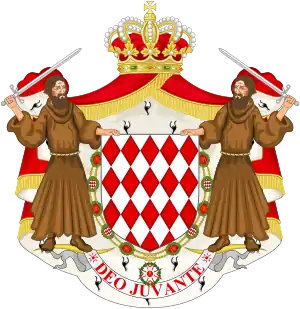Monarchy of Monaco
The Sovereign Prince (French: Prince de Monaco) or Princess of Monaco (French: princesse de Monaco) is the reigning monarch and head of state of the Principality of Monaco. All reigning princes and princesses have officially taken the name of the House of Grimaldi, although some have belonged to other families (Goyon de Matignon or Polignac) in the male line. The present reigning prince is Albert II.
| Sovereign Prince of Monaco | |
|---|---|
 | |
| Incumbent | |
.jpg.webp) | |
| Albert II since 6 April 2005 | |
| Details | |
| Style | His Serene Highness |
| Heir apparent | Jacques |
| First monarch | Honoré II (as Prince, previous rulers were called Lords until 1612) |
| Formation | 29 November 1604 |
| Residence | Prince's Palace |
| Website | Monarchy of Monaco |
 |
|---|
| This article is part of a series on the politics and government of Monaco |
Powers of the Prince
Monaco, along with Liechtenstein and Vatican City, is one of only three states in Europe where the monarch still plays an active role in day-to-day politics.
The Prince or Princess of Monaco exercises his or her authority in accordance with the Constitution and laws. He or she represents the Principality in foreign relations and any revision, either total or partial, of the Constitution must be jointly agreed to by the Prince and the National Council.[1]
Legislative power is divided between the Prince who initiates the laws, and the National Council which votes on them. Executive power is retained by the Prince. The Minister of State and the Government Council are directly responsible to the Prince for the administration of the Principality.[1]
Judiciary powers also belong to the Prince. The present Constitution states that the Prince has full authority in the courts and tribunals which render justice in his or her name.[1]
Pursuant to Article 16 of the 1962 Constitution, the Sovereign Prince confers orders, titles and other distinctions (see Awards and decorations of Monaco) as the fons honorum of the Principality of Monaco.[1]
Compensation
The princely family receives annual allocation from the budget of Monaco, €43.5 million in 2015.[2]
Titles and styles
The Prince is styled His Serene Highness.[3] Although used only formally, the Prince also bears several other hereditary titles, some of which are occasionally bestowed on his relatives or their spouses. Some of these titles have merged with the Crown of Monaco as a result of the Grimaldi family's acquisition of various fiefs;[3] they no longer imply ownership or territorial authority, although the Princes of Monaco have long been substantial owners of land and chateaux in France. Most were granted or recognised by the Kingdom of France or the Papal States and could only pass through the male line; they therefore became extinct as French dignities on the death of Albert's great-grandfather Prince Louis II in 1949. Thereafter, some of these titles were implicitly re-created as distinctly Monegasque titles.[3] The father of Prince Rainier III was Pierre Grimaldi, Duke of Valentinois, né Count Pierre de Polignac, whose legitimate male-line descendants (including Rainier III et al.) remain remotely in the line of succession for the French dukedom of Polignac).
The current Prince's complete titles and styles are, in precedent order of rank:
- Sovereign Prince of Monaco
- Duke of Valentinois
- Duke of Estouteville
- Duke of Mazarin
- Duke of Mayenne
- Prince of Château-Porcien
- Marquis of Baux (Title now used by Hereditary Prince)
- Marquis of Chilly-Mazarin
- Marquis of Guiscard
- Marquis of Bailli
- Count of Polignac (French title)
- Count of Carladès
- Count of Ferrette, Belfort, Thann and Rosemont
- Count of Torigni
- Count of Longjumeau
- Count of Clèdes
- Baron of Calvinet
- Baron of Buis
- Baron of La Luthumière
- Baron of Hambye
- Baron of Altkirch
- Baron of Saint-Lô
- Baron of Massy
- Seigneur (Lord) of Issenheim
- Seigneur of Saint-Rémy
- Sire of Matignon
Non-reigning princes(ses) of Monaco
"Prince(ss) of Monaco" is a title also given to legitimate members of the princely family of Monaco. It is distinct from the ruling Prince's title "Sovereign Prince of Monaco", currently Albert II, or with the title of the heir apparent or presumptive to the throne, currently Hereditary Prince Jacques. Charlene, Gabriella, Caroline, and Stephanie, are given Princess titles, as the wife and daughters of a sovereign prince.
See also
References
- "Principauté de Monaco: Portail officiel du gouvernment princier". Les Pouvoirs Souverains. Etat de Monaco: La Direction de l’Administration Électronique et de l’Information aux Usagers. Retrieved 23 November 2012.
- Hodgson, Camilla (1 August 2017). "Richest royals: what Europe's royal families get from their taxpayers". Business Insider. Retrieved 17 May 2020.
- Badts de Cugnac; Guy Coutant de Saisseval, Chantal (2002). Le Petit Gotha. Laballery. pp. 691–694, 699–703. ISBN 978-2950797438.
